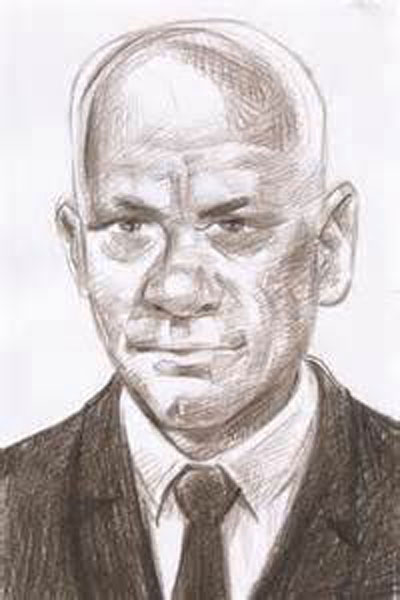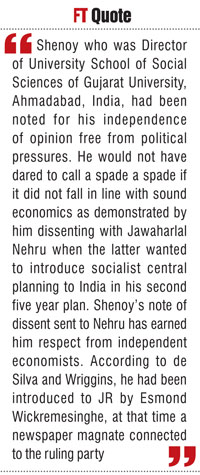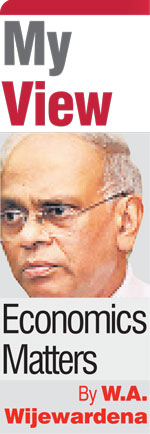Monday Jan 05, 2026
Monday Jan 05, 2026
Monday, 15 June 2015 00:00 - - {{hitsCtrl.values.hits}}

B.R. Shenoy
Shenoy, the classical libertarian economist
B.R. Shenoy, Indian classical libertarian economist, was no stranger to Sri Lanka. He was a lecturer in economics at the University College which was affiliated to the University of London initially and later became the University of Ceylon, in 1940s.
Many of those who became renowned Ceylonese economists in later years having passed out from the University College or the university proper during that period were his students. He was so reputed as a leading economist of the day that E. Eramudugolla, former Senior Deputy Governor of the Central Bank, mentions in his memoirs titled ‘Reminiscences of the Central Bank of Sri Lanka’ that, when the new Central Bank was set up, Shenoy was one of the economists who could have been drawn to the Bank to head its Economic Research Department.
But the offer went to another Indian economist at the University of Ceylon, B Das Gupta, who held the post only for 2 years. Had Shenoy come to the Central Bank as its first Director of Economic Research, it not only would have added one more laurel to his illustrious career as an independent economist but also sown the seeds of libertarian economics within the Central Bank of Sri Lanka.
Shenoy advising the government of Ceylon in 1966
Though Shenoy was no stranger to old Ceylon, he is in the present day little known in the country. But what is not known at all is that Sri Lanka lost a valuable opportunity to change the course of the nation by rejecting the advice he gave in mid 1960s to make a complete reform of the country’s economy and its economic policy.
JR looking for an independent economist in 1966
Shenoy was engaged in 1966 by J.R Jayewardene, then the Minister of State and Deputy Prime Minister and later President of Sri Lanka, when the economic crisis faced by the country had escalated to a critical level. According to K.M de Silva and Howard Wriggins, biographers of J. R Jayewardene of Sri Lanka, JR had looked for “an economist or economists who could come up with some fresh ideas on how to deal with the malaise in Sri Lanka’s economy”. JR, say his biographers, did not trust academics at Sri Lankan universities because they were Marxists or advocates of policies that promoted state expansion as the way out for Sri Lanka. Such state expansion has been the root cause of the economic malaise so it was quite natural for JR to look for someone who was free from such ‘state-worshipping ideologies’.
 Shenoy dissenting with Nehru on his socialist planning
Shenoy dissenting with Nehru on his socialist planning
Shenoy who was Director of University School of Social Sciences of Gujarat University, Ahmadabad, India, had been noted for his independence of opinion free from political pressures. He would not have dared to call a spade a spade if it did not fall in line with sound economics as demonstrated by him dissenting with Jawaharlal Nehru when the latter wanted to introduce socialist central planning to India in his second five year plan.
Shenoy’s note of dissent sent to Nehru has earned him respect from independent economists. According to de Silva and Wriggins, he had been introduced to JR by Esmond Wickremesinghe, at that time a newspaper magnate connected to the ruling party.
Shenoy: The student of Hayek
Shenoy would have been the ideal choice since he had been famous as a liberal economist highly influenced by another such liberal economist when he did his doctoral studies at the London School Economics in 1930s, namely, Friedrich A Hayek. Thus, unlike other Indian economists of the day, Shenoy had come under the strong influence of the Austrian School of Economics. Shenoy’s Guru, Hayek, was engaged by Margaret Thatcher to advise her how the British economy should be reformed after she came to power in 1979. Thus, Sri Lanka was literally one period ahead of Margaret Thatcher’s Britain when it engaged Hayek’s student, B R Shenoy, to do the same job 13 years earlier.
An economy under siege
At the time Shenoy was hired, Sri Lanka’s economy had been under siege on many fronts. It had a comfortable foreign exchange reserve sufficient to meet 13.4 months of imports at the time it gained independence in 1948. However, this reserve continued to decline in subsequent years and had fallen to 1.9 months of imports by 1966. The main reason for this unsavoury development was the weak balance of payments position of the country that heavily depended on the export of three major tree crops, namely, tea, rubber and coconut, to meet all its import requirements. As such, the balance of payments was continuously in deficit from around 1956 causing a heavy haemorrhage of its foreign reserves.
Getting into a public debt trap
On the budgetary front, the country had overspent its resources running a continuous overall budget deficit in the region of about 5-7% of GDP prompting Singapore’s Lee Kuan Yew to call Sri Lanka a country notorious for living by auctioning non-existent assets. The fragile budgetary situation had further weakened when the successive governments since independence, especially after 1956, followed a policy of state expansion committing the scarce resources of the government, and also of the country, to maintain an ever expanding state sector.
The undesired corollary was for the government to borrow heavily to incur deficit financing, specifically from the domestic markets. Accordingly, the total public debt which had stood at 18% of GDP in 1948 had shot up to 66% of GDP by 1966. Since the government was running a sizeable budget deficit, the repayment of public debt as well as payment of interest thereon was done by resorting to further borrowing thereby entrapping the country in a vicious debt trap.
Suppressing inflation through price controls
Meanwhile, money supply had increased over and above the growth in the real economy putting pressure for the prices to go up. This was evident from the substantial increase in the money-GDP ratio from 17% in 1950 to 29% in 1966 and the need for the government to resort to widely applied price and foreign exchange controls to suppress price inflation and pressure for devaluation of the rupee. Economic growth during 1950-66 had been at an average level of slightly above 3% per annum.
Shenoy to rescue Sri Lanka
This was the economic situation in Sri Lanka when Shenoy was engaged by the government to study and report on the necessary economic reforms to be implemented in the country.
Shenoy submitted his report titled ‘Economic Situation and Trends in Ceylon: A Programme of Reform’ to the government in December 1966. This writer had the opportunity to master the report which remains in mimeograph form in the J.R Jayewardene Centre in Colombo.
 Shenoy making recommendations ahead of the time
Shenoy making recommendations ahead of the time
The report by any standard was well ahead of the time. Even the biographers of J R Jayewardene have remarked as follows: “Present-day readers of Shenoy’s report would be struck by the influence it shows of the views of Ludwig von Hayek (sic), Milton Friedman and the Chicago School of Economists would immediately claim him as one their own. Needless to say that such views had little chance of adoption in Sri Lanka in the 1960s, but the significance of the report lies in the fact that many of its recommendations were adopted in November 1977 and thereafter by the UNP government led by J.R”.
The reference to ‘Ludwig von Hayek’ above is in fact a reference to two different economists belonging to the Austrian School of Economics, namely, Ludwig von Mises and Friedrich A Hayek. Shenoy’s recommendations were ahead of the time, since none of the countries in South Asia at that time would dare to even consider them as viable thereby making their adoption a complete non-issue. As a result, according to JR’s biographers, he did not get support of the Cabinet when they were presented to his Cabinet colleagues for consideration. Yet Singapore, a nation ranked at the same economic status as Ceylon at that time, implemented a policy package similar to that recommended by Shenoy as from mid 1960s. Through that policy, Singapore was successful in producing an economic miracle by lifting that nation to the status of a developed country within a single generation.
Three Ps of economic maladies
Shenoy starts his report by remarking that Ceylon’s economy has been inflicted with 3Ps of maladies in 1950s and 1960s, namely, the maladies of production, prices and (balance of) payments. While the bad performance of these three attributes record economic ill health, the good performance of them is a sign of economic good health, according to Shenoy. He asserts that correct diagnosis of the ailment is only half of the cure; the full cure lies in taking remedial policies to address them as in the case of addressing a human ailment.
Sri Lanka failing to realise its economic potential
Shenoy found that economic growth during 1960-65 amounted to less than 2% and, with a population growth of 2.7%, the per capita income had been declining. However, the meagre economic growth was conveniently appropriated by the higher echelon of society facilitating them to “maintain their consumption standards at undiminished levels of affluence”.
What it meant was, according to him, a more rapid erosion of mass well-being than national income statistics suggested. His prognosis was that such growing inequality in income distribution was a “serious matter in a democracy, especially in the context of two more or less evenly balanced party alignments, where the opposition is ever on the alert to capitalise on the errors of policy ill-effects of the party in power”. Hence, he opined that “a major policy objective should be to halt the decline in the living standards of the masses and to reverse this trend without delay”. Shenoy was prophetic in his prognosis as demonstrated by the youth insurrection of 1971. Had political leaders taken his advice seriously, the bloody insurrection that ended in the loss of thousands of young lives could have been avoided.
Libertarianism is not for income inequality
To many, libertarian economics means supporting capitalists at the expense of the masses at large. But that is not the case. While libertarian economics upholds the liberty of choice, whether it is by the capitalist or by the worker, it necessarily frowns upon a growing inequality in income distribution leading to social, economic or political disorder. Hence, it always recommends policies to prevent such a situation. Shenoy’s observation and recommendation were in line with this thinking. Sri Lanka’s was a classic case where, despite many pro-poor policies adopted, Gini coefficient of income equality/inequality remained stubbornly at about mid level at 0.5 throughout its post independence history indicating wide income inequality. All the successive governments of Sri Lanka had to pay a heavy price for their failure to take notice of his recommendation.
Misleading cost of living indices
About inflation, Shenoy notes, as it is true for Sri Lanka even today, that “the cost of living index does not seem to present the full picture of the extent of price inflation” since that index had been vitiated by controlled prices that do not show the price changes in response to emerging market conditions. He found that since money supply had increased faster than the real economic growth, inflationary pressure had been there; but due to controlled prices, inflation had not been reflected in the cost of living index.
Shenoy noted that successive governments had resorted to bank financing to meet their capital expenditure programmes since the domestic savings had not been adequate. In fact Shenoy notes that the single largest impediment to accelerate economic growth in Ceylon had been “the shortage of national savings”. Hence, he notes that “inflation in Ceylon cannot be controlled without balancing the Budget” just like “the problem of flood control cannot be tackled by restricting the water down the canals”. Hence, it is the source that has to be beaten and not the symptoms.
Balancing the budget while generating government savings
Shenoy, therefore, suggests a series of actions to balance the budget before it balloons to unmanageable levels. Since Ceylon had a satisfactory revenue ratio at about 22% of GDP in 1950s and 1960s, as against 12% today, he does not recommend an increase in taxation which will reduce national savings further. Instead, he recommends halting expenditure leakages in the form of unproductive subsidies, expansion of the state sector and non-rationalisation of the capital expenditure programmes.
Hence, Shenoy has recommended the denationalisation of selected state corporations in fisheries, manufactures and trading and increase in the current account surplus of the budget by reducing unnecessary recurrent expenditure programmes so that capital expenditure could be undertaken wholly by using such surplus. The implication of this latter recommendation is that it would generate a zero overall deficit in the budget which is non-inflationary and supportive of Central Bank’s monetary policy actions to control inflation. But what has happened throughout the post-independence period had been that the Government had been generating inflation and the Central Bank punishing the private sector by imposing restrictive monetary policies.
Listing state corporations in the stock exchange
While recommending that selected state corporations should be denationalised, he has recommended that other state corporations be listed in the stock exchange so that they would be disciplined by the market instead of political authorities.
This measure would also help them to mobilise funds from the market for capital expenditure programmes by allowing their internal strengths to be tested in the market instead of relying on the government. It should be noted that during this era, the stock exchange was vibrant with the share transactions of plantation companies and what Shenoy had suggested was to augment its operations by listing public corporations as well.
Give cash subsidies instead of commodity subsidies
He also had recommended that consumer subsidies should be scaled down and the popular rice subsidy that was prevalent at that time should be replaced by a cash subsidy instead of a commodity subsidy. Such a measure, while helping the needy with government support, would keep the budgetary commitments at a fixed level making it easy for long term budgetary planning.
While the expenditure side of the budget should be tackled by these measures, he had suggested that the tax rates which stood at 80% at the margin too should be scaled down drastically in order to promote national savings, since, according to him, “taxation destroys potential national savings into a bon-fire of public consumption” which has not helped the economy to pick up. He also has opined that the public’s concern for Ceylonisation of foreign enterprises could be fulfilled by freeing the public from high marginal tax rates and increasing their savings potential. Many years later, American economist Arthur Laffer also came up with this Shenoy Theorem with what later came to be known as Laffer curve that depicted that when tax rates are increased beyond a certain level, tax revenue would fall instead of increasing.
Float the rupee and remove exchange and import controls
The most revolutionary proposal by Shenoy was to adopt a completely freely floating exchange rate to address the persistent balance of payments difficulties in the wake of uncertainty about the receipt of donor funding. It should be noted that this recommendation was two decades ahead of global best practices which advocated flexible exchange rates. The strict exchange and import controls have generated a massive black market for foreign exchange on one and a thriving smuggling business on the other.
The reaction of authorities was to impose more and more penalties on the culprits. Hence, there was a substantial disparity between the official exchange rate and black market rate; the result was the over invoicing of imports and under invoicing of exports so that saved foreign exchange could be lucratively sold in the black market. Shenoy had termed it as ‘disastrous for the country’s balance of payments. Hence, he recommended abolition of exchange controls, import and export restrictions and liberalisation of external trade along with the floating of the rupee.
Costly disregard of Shenoy’s recommendations
Shenoy’s recommendations were well ahead of their time and similar to the reform package adopted by Singapore. According to the biographers, JR was impressed by the policy reform package suggested by Shenoy.
However, when it was submitted to the Cabinet, Prime Minister Dudley Senanayake is reported to become nervous thinking that it is a ploy by JR to oust him from leadership, according to the biographers. Hence, the policy package was dismissed and it remained a dusty document with JR till it was transferred to the J.R. Jayewardene Centre in Colombo as a vital document.
It is therefore another instance of Sri Lanka missing an opportunity to reform the economy and set it on a firm recovery road. Strangely, Sri Lanka’s economy today is mostly afflicted by the same maladies and Shenoy recommendations could be adopted without any amendment.
(W.A Wijewardena, a former Deputy governor of the Central Bank of Sri Lanka could be reached at [email protected] )